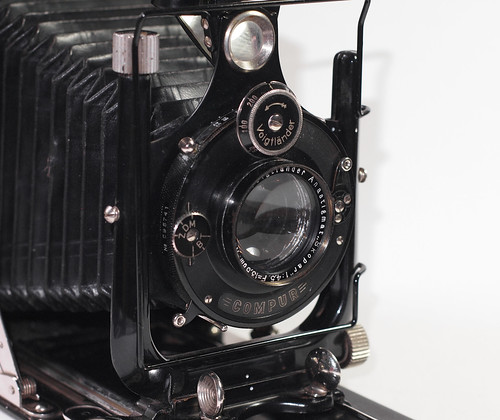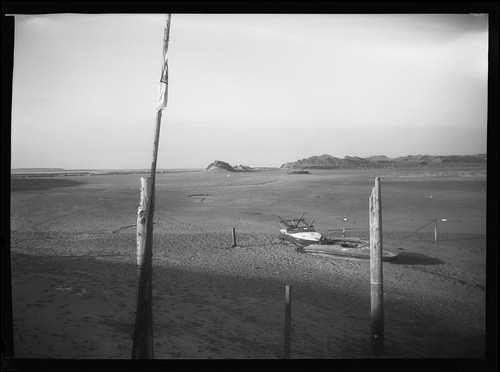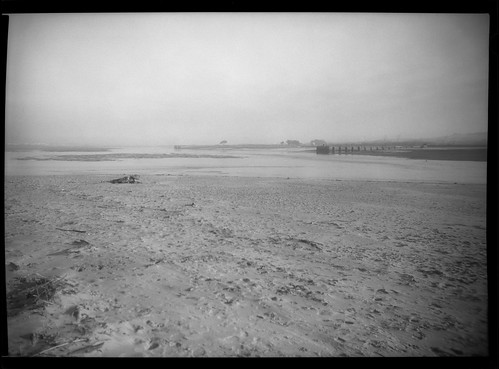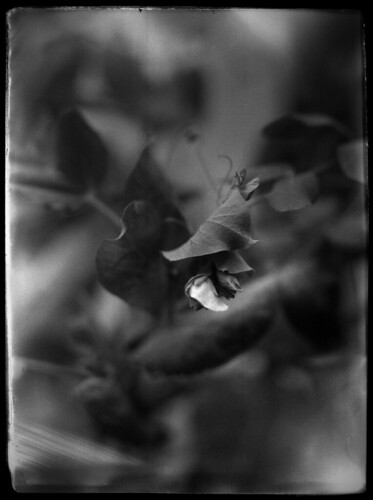 |
| Voigtländer Avus |
The
Voigtländer Avus was my first 9x12cm format folding camera. I initially bought it as a relatively inexpensive and compact large format camera; I did subsequently buy a 4x5 camera not long afterwards, but also found other 9x12cm cameras after the Avus: the
Kodak Recomar 33 (which was extremely cheap); the
Ica Trona; and the Photo Plait camera (as a format, 9x12cm sheet film is still made: it's essentially the continental European metric equivalent of 4x5 inch film, although not as common). The Avus was the mid-range option of Voigtländer's stable of plate cameras, between the lower-priced Vag cameras and the top-of-the-range
Bergheil: the Bergheil cameras seem to have been entirely contemporary with the Avus, while the Vag was introduced later, as a more economical option. The Avus appears to be a relatively common camera, and presumably made in fairly large numbers; it was produced from 1913 to 1934 (some sources give 1914-1935, or -1936), with some minor changes throughout the two decades of that run. My camera is the 9x12cm version that appeared in 1927, clearly identified by the centrally-positioned brilliant finder directly above the lens, rather than offset to one side, as with most plate cameras of this date. Two different origins of the camera's name are given in different sources: one suggestion is that the name is formed from the initials
A.V.U.S., as seen on the ground glass back on early versions, derived from "Aktiengesellschaft Voigtländer Und Sohn"; Camera-Wiki states that it was named after an early motor racing circuit in Berlin, the
AVUS, also an acronym. This AVUS was under construction when the camera appeared, but not opened until 1921, so it seems highly unlikely that Voigtländer would have been deriving some name recognition from the racetrack's popularity.
 |
| Voigtländer Avus - side view |
The Avus was made in a number of different formats: there is a horizontal 9x12cm plate version, a 10x15cm, one dual-format version for 9x12cm plates and 122 rollfilm, but the most common sizes are the vertically-oriented folding cameras for 6.5x9cm and 9x12cm plates. Like many folding plate cameras of its time, the Avus was provided with different lens and shutter combinations. My version of the Avus has a 13.5cm f4.5 Skopar lens, Voigtländer's own version of the Tessar, in a Compur dial-set shutter, which together would have been the most expensive options at the time.
 |
| Detail with Voigtländer Skopar lens in Compur dial-set shutter |
The other features of the Avus are double extension bellows; limited movements in the form of front rise and cross; a rotating brilliant finder with spirit level, and a wire frame viewfinder. Focus is with a ground glass screen; the front standard is focussed with a rack and pinion knob, which pulls out to turn, pushing in to lock the focus. There is also a focus scale on the bed - which needed adjusting, as this was initially out of true: when first using the Avus, I relied on the infinity stop of the focus scale, and found most of the images out of focus as a result (the focus scale can be adjusted with a couple of small screws that, once loosened, can be moved backwards or forwards a small amount). The removable ground glass screen was missing from my camera; ground glass screens, unlike spring backs, have a tendency to get separated from their cameras. I made a ground glass screen from a 9x12cm film pack adaptor which came with the camera, and lacking a focus shade it does have the benefit of opening completely out, without a viewing hood, which I found useful when using the camera for night photography, but, for general use, I have tended to use the ground glass screen from the Recomar.
 |
| Avus with bellows extended |
Over the years, I've picked up various 9x12cm plate holders, some Voigtländer-branded ones, a number of which came with film sheathes, essential for shooting sheet film with the camera. The Avus is compatible with all the plate holders I have, which is not the case with the Recomar. As the Avus was my introduction to large format, I experimented with paper negatives and Harman Direct Positive paper for ease of loading and development under darkroom safelights. I used a sheet of stiff card behind the photographic paper in the plateholders before I had acquired the necessary film sheathes. When I first started to shoot sheet film with the camera, I
attempted tray processing, but found it too difficult to get even development with the negatives and also found it too easy to scratch the film: I had been using Foma film, which in my experience has a soft emulsion compared to others, very easy to damage while wet. I subsequently got a Combi-Plan tank to develop large format film and plates, which I have found much easier to develop sheet film with.
 |
| Voigtländer Avus - paper negative, digitally inverted |
What drew me to the Voigtländer Avus was its compactness in relation to its negative size: the camera is the size of a fat paperback book. Using it handheld, my general procedure was to focus on the ground glass screen, then replace this with a plateholder or rollfilm back, and use the wireframe finder to compose the shot. I've remarked before on my preference for the dial-set Compur shutter over the later rim-set version for ease of use: when focussing with the ground glass screen, with the shutter speed set, the selector for the I/B/T setting can be quickly turned between 'T' to open the shutter and 'I' for taking the shot.
 |
| Voigtländer Avus with Agfapan APX100 |
I also invested in a Rada Plaubel rollfilm back for the 9x12cm format for the ease of using medium format film with the camera, with a much wider selection of films available, as well as being easier to develop.
 |
| Voigtländer Avus with Adox CHS 100 in rollfilm back |
The
Proxar and Distar supplementary lenses that I used with the Ica Trona - which I found at the time I bought the Trona - also fit the 37mm lens mount on the Voigtländer Avus; the Proxar lens can be used as both a close up filter and a wide angle one due to fact that it's possible to reduce the distance between the camera's lens and film plane in order to achieve infinity focus. With a full 9x12 frame, there is some vignetting and distortion towards the edges of the frame, as can be seen in the image below; a narrower aperture might reduce this somewhat.
 |
| Voigtländer Avus and Proxar with Fomapan 100 |
With the roll film back, the 6x9cm medium format frame, normally cropped of course, approaches an equivalent angle of view as the full 9x12cm frame without the Proxar: the two images below give a good comparison in terms of the difference the Proxar makes. On the 6x9cm frame, the vignetting and distortion lies outside the image area; it does appear to make the image softer however.
 |
| Voigtländer Avus with Ilford XP2 Super in rollfilm back |
 |
| Voigtländer Avus with Ilford XP2 Super in rollfilm back and Proxar lens |
In use, although the Avus is well-made, I found that the front standard on my camera had a tendency to hold the lens a little out of parallel to the focal plane, possibly due to tension or simply the weight of the bellows on the unsupported top of the front standard, with the result that the plane of focus in photographs taken with the Avus would often shift across the scene in front of the camera, less noticeable with smaller apertures of course. As well as this issue, the Skopar lens on the camera, uncoated of course, was very soft, prone to halation: this is clear in the image below with the sky backlighting the subject, creating a haze around the ruin.
 |
| Voigtländer Avus with Rollei Superpan 200 in rollfilm back |
Although the Kodak Recomar 33 has a slower lens, and a simpler shutter, I have found this easier to use than the Avus. The Recomar has a triplet lens, the Radionar, which is around the same age as the Avus' Skopar, but on my cameras, it gives a better result, and so I've used the Recomar in recent years in preference: although it was my introduction to large format I found the Voigtländer Avus frustrating to use, and I never felt like I quite got the quality of the images from the camera that I felt it promised.
 |
| Voigtländer Avus with Adox CHS 100 in rollfilm back |
 |
| Voigtländer Avus with Ilford HP5 Plus in rollfilm back |
 |
| Voigtländer Avus with XP2 Super in rollfilm back and Proxar lens |
 |
| Voigtländer Avus with Ilford Soft Gradation Panchromatic glass plate (label dated to 1947) |
 |
| Voigtländer Avus with Ilford HP3 glass plate (1950s) |
 |
| Voigtländer Avus with Ilford HP3 glass plate (1970s) |
 |
| Voigtländer Avus with Fomapan 400 |
 |
| Voigtländer Avus with HP5 Plus |
Sources/further reading:
Full range of Voigtländer Avus Models
Voigtländer Avus on Camera-Wiki
Early Photography on the Avus
Voigtländer Avus on J. Noir Cameras
Voigtländer Avus on Collection-Appareils
Camaras sin Fronteras - Avus (with manuals and original adverts) (in Spanish)
Voigtländer Avus manual



















Wow! Great article!!
ReplyDeleteExcelente!!! También tengo una Avus! Espero pronto revelar las fotos!!
ReplyDeleteVery good article and helpful, I just bought myself a Avus Compur 9x12 camera, exiting. Looking forward to start painting with the light. Thanks for this helpful and informative article on this camera legend.
ReplyDeleteThank you for your comments - enjoy using the camera!
DeleteVery nice review. Well done. I've the same camera in use.
ReplyDeleteAll this pics are taken with the lens of the Avus.
ReplyDeleteThe bellows is from a Zeiss Ikon
https://www.instagram.com/minutera_ambulante/
Thanks for sharing this - it looks like a really interesting project.
Delete